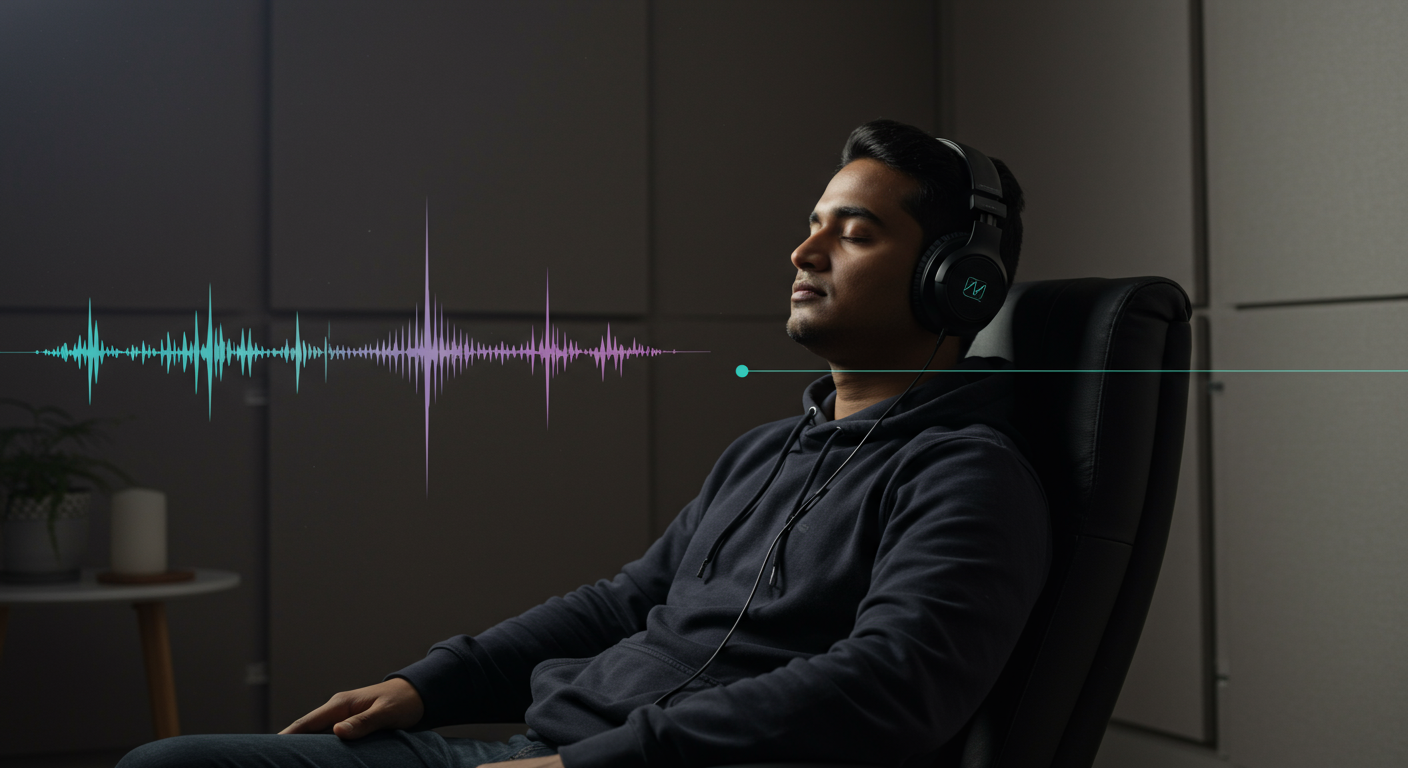The Sleep Heretic's Guide: Hacking Your Brain with Binaural Beats for Deep Sleep

Struggling to sleep?
Learn how to use binaural beats—a simple audio illusion—to guide your brain into deep, restorative sleep. Discover the science and a simple 3-step workflow.
Tired of counting sheep? If you've optimized your evening routine and still find yourself staring at the ceiling, it might be time for a more unconventional approach. As a sound professional, I'm always looking for efficient, lazy-proof ways to achieve a goal. When it comes to sleep, one of the most intriguing tools in the sonic arsenal is the binaural beat—a simple, effective audio illusion that can guide your brain into a state of deep, restorative sleep.
The Monk's Guide to Brainwaves: What Are Binaural Beats?
Simply put, a binaural beat is a sonic trick played on your brain. It happens when you listen to two slightly different frequencies, one in each ear (this is why you need stereo headphones). For example, your left ear might hear a 130 Hz tone, while your right ear hears a 134 Hz tone.
Your brain, in its effort to make sense of this, perceives a third, phantom beat at the difference between the two frequencies—in this case, 4 Hz. This process is called "brainwave entrainment." You're essentially nudging your brain to sync up with a specific rhythm.
Different rhythms, or frequencies, are associated with different states of consciousness:
- Beta (13-30 Hz): Active, alert, focused.
- Alpha (8-13 Hz): Relaxed, calm, meditative.
- Theta (4-8 Hz): Light sleep, deep relaxation, REM.
- Delta (0.5-4 Hz): Deep, dreamless sleep.
To hack our sleep, we're interested in the Delta frequency range. By presenting your brain with a Delta wave binaural beat, you can encourage it to shift down gears, moving from an alert state to one primed for deep sleep.
The 3-Step Workflow for Instant Sleep Hacking
True to the spirit of finding the most direct path, here’s a simple, no-fuss workflow to get started tonight.
Step 1: Choose Your Frequency You're aiming for the Delta range (0.5-4 Hz). This is the sweet spot for encouraging deep, restorative sleep. You can find countless pre-made tracks on YouTube, Spotify, and dedicated apps. Search for "delta wave binaural beats for sleep."
Step 2: Gear Up This is non-negotiable: you must use stereo headphones or earbuds. The entire effect relies on delivering separate frequencies to each ear. The type doesn't matter as much as the stereo separation. Use whatever is comfortable enough to fall asleep with.
Step 3: Set the Scene Press play about 15-30 minutes before you want to be asleep. Keep the volume low; it should be a subtle, underlying hum, not a distraction. Dim the lights, put your phone away, and settle into your most comfortable sleeping position.
Does It Actually Work? The Science in 60 Seconds
While the internet is full of anecdotal success stories, the scientific community remains cautiously optimistic. Several small studies have shown promising results. Research has indicated that listening to Delta wave binaural beats can help reduce anxiety, improve sleep quality, and even influence hormones related to sleep, like cortisol and melatonin.
However, it's not a magic bullet. Some studies have found limited effects, and it's clear that responses can vary from person to person. Think of it as a tool, not a cure. The risks are minimal, so if you find it helps you relax and drift off, that's a win.
Pro-Tip for the Sound Savvy
For those who like to experiment, try layering your binaural beats. Find a pure Delta wave track and play it underneath another soundscape you find relaxing. This could be:
- Pink or Brown Noise: These are great for masking external sounds.
- Ambient Music: Think low, droning synths or gentle pads.
- Nature Sounds: A gentle rainstorm or distant thunder can work wonders.
This "sound stacking" can make the experience more immersive and mask any potential harshness from the pure tones, creating your own custom sleep-inducing cocktail.
Final Beat
Binaural beats offer a fascinating, low-effort method to potentially improve your sleep. By leveraging the brain's own mechanics, you can create an internal environment that's conducive to rest. It’s a perfect example of an unconventional, minimalist solution to a common problem—a true lazy person's hack for a better night's sleep. So, grab your headphones and give it a try. You have nothing to lose but a few hours of restlessness.